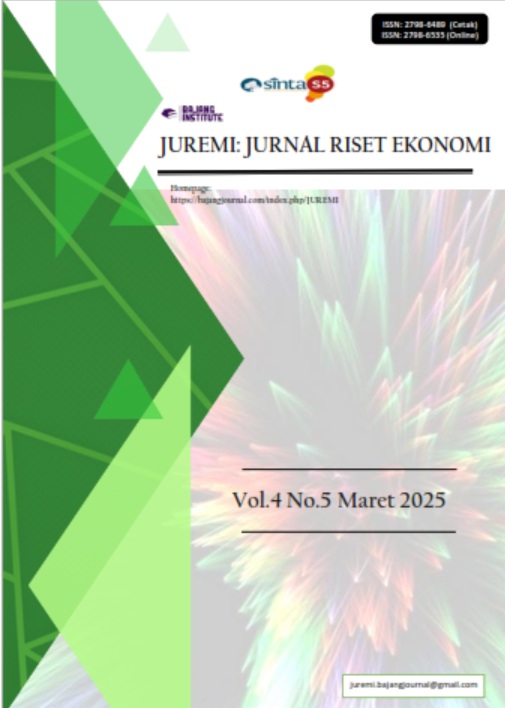DAMPAK PERSEPSI PENTINGNYA ISU SOSIAL DAN PUBLIKASI NEGATIF TERHADAP DUGAAN DUKUNGAN STARBUCKS TERHADAP ISRAEL DALAM KONFLIK GAZA TERHADAP KEPUTUSAN PEMBELIAN PELANGGAN DI MANADO
DOI:
https://doi.org/10.53625/juremi.v4i5.9973Keywords:
Social Issues, Negative Publicity, Purchase Decision, Starbucks.Abstract
This study examines how the perceived importance of social issues and negative publicity regarding Starbucks' alleged support for Israel in the Gaza conflict affect customer purchase decisions in Manado, Indonesia. A quantitative approach was used, with 100 respondents selected via stratified random sampling. The results show that while the perceived importance of social issues does not significantly impact purchase decisions, negative publicity has a strong and significant influence. Moreover, the combined effect of these factors significantly affects consumer behavior. These findings emphasize the power of negative publicity in shaping purchasing decisions, particularly in contexts involving politically sensitive issues. The study provides insights for businesses on how social and political narratives can influence consumer choices in emerging markets.
References
Aaker, D. A. (2014). Brand relevance: Making competitors irrelevant. John Wiley & Sons.
Ajzen, I. (1991). The theory of planned behavior. Organizational Behavior and Human Decision Processes, 50(2), 179-211. https://doi.org/10.1016/0749- 5978(91)90020-T.
Bryman, A. (2016). Social research methods (5th ed.). Oxford University Press.
Cohen, L., Manion, L., & Morrison, K. (2018). Research methods in education (8th ed.). Routledge.
Coombs, W. T. (2007). Ongoing crisis communication: Planning, managing, and responding (2nd ed.). Sage Publications.
Crijns, H., Cauberghe, V., Hudders, L., & Claeys, A. S. (2017). How to deal with online consumer comments? The impact of three strategies on brand loyalty. Journal of Business Research, 77, 12-19. https://doi.org/10.1016/j.chb.2017.05.046.
Field, A. (2013). Discovering statistics using IBM SPSS Statistics (4th ed.). Sage Publications.
Hair, J. F., Black, W. C., Babin, B. J., & Anderson, R. E. (2010). Multivariate data analysis (7th ed.). Pearson Education.
Handarkho, Y. D. (2020). Impact of social experience on customer purchase decisions in the social commerce context. Journal of Systems and Information Technology, 22(1), 47–71. https://doi.org/10.1108/jsit-05-2019-0088.
Haynes, S. N., Richard, D. C. S., & Kubany, E. S. (1995). Content validity in psychological assessment: A functional approach to concepts and methods. Psychological Assessment, 7(3), 238–247. https://doi.org/10.1037/1040-3590.7.3.238
Hennig-Thurau, T., Gwinner, K. P., Walsh, G., & Gremler, D. D. (2010). Electronic word-of-mouth via consumer-opinion platforms: What motivates consumers to articulate themselves on the internet? Journal of Interactive Marketing, 24(2), 38-52. https://doi.org/10.1002/dir.10073.
Ingenbleek, P., Meulenberg, M., & Trijp, H. (2015). Buyer social responsibility: a general concept and its implications for marketing management. Journal of Marketing Management, 31, 1428 - 1448. https://doi.org/10.1080/0267257X.2015.1058848.
Klein, J. G., Smith, N. C., & John, A. (2004). Why we boycott: Consumer motivations for boycott participation. Journal of Marketing, 68(3), 92-109. https://doi.org/10.1509/jmkg.68.3.92.34770.
Kotler, P., & Keller, K. L. (2016). Marketing management (15th ed.). Pearson Education.
Kotler, P., & Armstrong, G. (2010). Principles of marketing (13th ed.). Pearson Education.
Kotler, P., Burton, S., Deans, K., Brown, L., & Armstrong, G. (2015). Marketing (9th ed.). Pearson Higher Education AU.
Leedy, P. D., & Ormrod, J. E. (2019). Practical Research: Planning and Design (12th ed.). Pearson.
Maslikhan, M. I. (2019). The effect of negative publicity on brand equity (image, attitude, and purchase intention) in Indonesia: Case of Dolce and Gabbana racism scandal. International Journal of Business and Administrative Studies, 5(3). https://dx.doi.org/10.20469/ijbas.5.10004-3.
Mohr, L. A., Webb, D. J., & Harris, K. E. (2001). Do consumers expect companies to be socially responsible? The impact of corporate social responsibility on buying behavior. Journal of Consumer Affairs, 35(1), 45-72. https://doi.org/10.1111/j.1745-6606.2001.tb00102.x.
Pandya, S., & Venkatesan, R. (2016). French Roast: Consumer Response to International Conflict—Evidence from Supermarket Scanner Data. Review of Economics and Statistics, 98, 42-56. https://doi.org/10.1162/REST_a_00526.
Roozen, I., & Raedts, M. (2020). The power of negative publicity on the fast fashion industry. Journal of Global Fashion Marketing, 11, 380 - 396. https://doi.org/10.1080/20932685.2020.1798802.
Schiffman, L. G., & Kanuk, L. L. (2010). Consumer behavior (10th ed.). Pearson Education.
Sen, S., & Bhattacharya, C. B. (2001). Does doing good always lead to doing better? Consumer reactions to corporate social responsibility. Journal of Marketing Research, 38(2), 225-243. https://doi.org/10.1509/jmkr.38.2.225.18838.
Singh, K. (2007). Quantitative social research methods. SAGE Publications
Solomon, M. R. (2018). Consumer Behavior: Buying, Having, and Being (12th ed.). Pearson.
Wesley, S. C., Lee, M.-Y., & Kim, E. Y. (2012). The Role of Perceived Consumer Effectiveness and Motivational Attitude on Socially Responsible Purchasing Behavior in South Korea. Journal of Global Marketing, 25(1), 29–44. https://doi.org/10.1080/08911762.2012.697383.
Yu, M., Liu, F., Lee, J., & Soutar, G. (2018). The influence of negative publicity on brand equity: Attribution, image, attitude and purchase intention. Journal of Product & Brand Management. https://doi.org/10.1108/JPBM-10-2017- 1614.
















